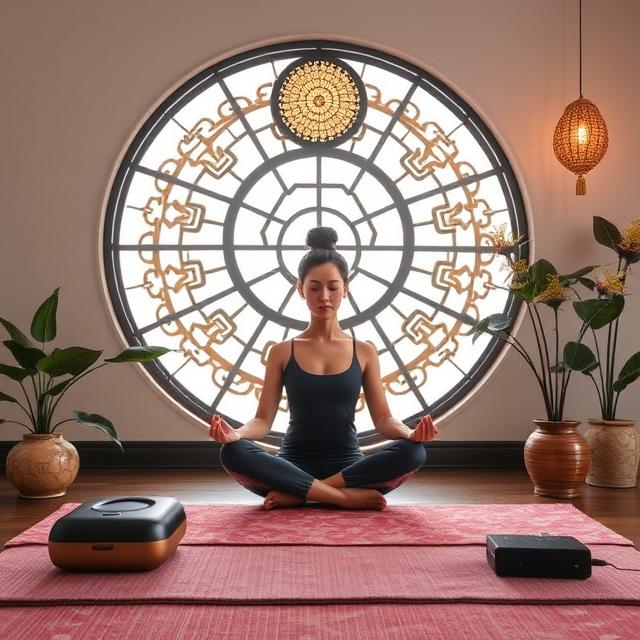The combination of ancient practices and modern technology is transforming the landscape of managing stress in the modern world. When it comes to meditation practice for anxiety, the coming together of electronic devices with traditional Chinese meditation techniques is enhancing mental calmness, control of breathing, and mental balance. This involves smart headbands, meditation software for guided meditation, and biofeedback systems that help individuals monitor and enhance mindfulness practice based on the fundamental principles of ancient Chinese traditions.
Blending Technology with Tradition
Ancient Chinese meditative exercises are rooted in traditional practices like Qigong, Tai Chi, and Taoist breathing. These are meditative exercises that emphasize movement of energy, coordination of breath, and awareness of the body. These exercises are said to be taxing for inhabitants of the modern world who fail to become adjusted to experiencing tiny sensations of energy.
Here is where technology steps in. Devices like Muse headbands and Heart Math sensors keep track of brain waves and heart rate variability and give feedback immediately. When someone begins in meditation practice for anxiety, the device lets him know whether his body is relaxing or not. They make things that are not tangible into things that are tangible, accelerating learnability of the skill and improving focus.
Biofeedback Devices and Their Benefits
One of the most valuable tools to improve meditation against anxiety is a biofeedback machine. These machines monitor your physiological state, breathing rate and skin conductivity during meditation. Matching this feedback to Chinese meditation techniques, individuals can better integrate posture, breathing, and inner concentration.
Biofeedback devices often use visual or audio signals to indicate when you’ve entered a calm state. This real-time feedback loop helps refine technique and promotes self-awareness. When applied consistently, these tools turn traditional ongoing meditation practices into something measurable and highly personalized.
Using Apps for Guided Meditation and Progress Tracking
In addition to wearables, mobile apps are also showing significant contribution in the development of an anxiety meditation practice. Mobile apps such as Insight Timer, Calm, or Breathe provide guided meditations that incorporate Chinese meditation techniques in the Daoist body scan and breathing exercises based on Qigong.
Some stress-relief apps include session types like “Evening Calm,” “Morning Mindfulness,” and “Anxiety Reset.” With the feature to monitor progress and remind the user on a daily basis, the practice becomes habitual, which is necessary to bear fruits. Incorporating breathing patterns into the classic Chinese meditation can increase the anxiety-reducing effect.
Smart wear and Environment Control
You also own home automation gear which can be used to complement your meditation practice for anxiety. Noise-rejection headphones eliminate distractions, and home automation lighting systems can simulate a peaceful dawn or setting evening dusk, allowing circadian entrainment in morning or evening meditation.
Equipment like aroma diffusers are able to mimic the traditional incense used in ongoing meditation practices, with sensory triggering and enabling a feeling of immersion. It does away with the facilitation of effortless relaxation and putting the practitioner in the moment as well. Combined with mindfulness technology, it is an oasis that’s ideal for the relief from anxiety.

How to Use Gadgets to Improve Chinese Meditation Practice for Anxiety
Measuring Progress and Reducing Anxiety
Consistency and regularity are required for reducing anxiety in the long run in a sustainable way. Devices allow one to monitor parameters that range from heart rate, sleep patterns, and moods with empirical data that prove that their meditation against anxiety is effective. Most devices have a feature of syncing data to mobile dashboards, showing long-term trends, and reminding them of the need for motivation.
With these devices integrated into Chinese meditation techniques, the users gain an awareness of the effects of posture, breathing, and energy balance on stress. Having practiced, they gain an internal compass for remaining relaxed regardless of the devices themselves.
Customizing Practice to Accommodate Varying Needs
Everyone’s anxiety is unique. Some need mobilization, and others prefer immobilization. The adaptability of contemporary technology allows them to customize their meditation practice for anxiety to meet their mind and body needs. With or without breath sensors employed in Qigong exercise or guided Taoist meditations through an app, one can individualize without compromising on traditional principles.
Gadgets can enhance meditation practice for anxiety by blending real-time feedback with Chinese meditation techniques for effective and customized relief.
The Rise of Smart Gardening Tools Machines and Online Accessories
How to Choose the Best Smart Lock for Alexa and Home Assistant



